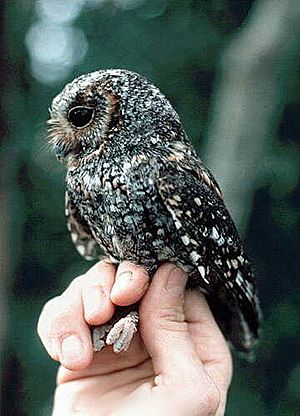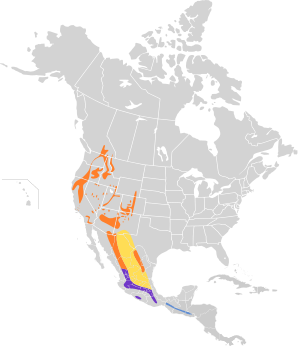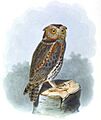Flammulated owl facts for kids
Quick facts for kids Flammulated owl |
|
|---|---|
 |
|
| Conservation status | |
| Scientific classification | |
| Genus: |
Psiloscops
|
| Species: |
flammeolus
|
 |
|
| Synonyms | |
|
Otus flammeolus |
|
The flammulated owl (Psiloscops flammeolus) is a small owl that is active at night. It is about 15 centimeters (6 inches) long. Its wingspan is around 36 centimeters (14 inches). These owls have large wings for their small bodies. This helps them fly very fast from tree to tree.
You can tell male and female flammulated owls apart by their weight. Females are a bit bigger, weighing about 62 to 65 grams (2.2 to 2.3 ounces). Males are smaller, weighing 50 to 52 grams (1.8 to 1.8 ounces). The owl gets its name "flammulated" from the flame-like marks on its face.
These owls breed in southern British Columbia and the western United States. They also breed in central Mexico. Unlike many owls, flammulated owls migrate. They leave Canada and the United States in the fall. For winter, they fly south to northern Central America. This includes southern Mexico, Guatemala, and El Salvador. They leave their breeding areas in August. They return in late April and early May.
The flammulated owl looks a bit like the western screech owl. However, it is much smaller, only about one-quarter the weight. It also has very small ear tufts that are hard to see. Its eyes are dark, and its voice sounds different. The elf owl is smaller than the flammulated owl. The mountain pygmy owl is about the same size. The flammulated owl's call is a series of deep hoots, either single or double.
Contents
Owl Homes: Nesting Habits
Flammulated owls make their nests inside holes in trees. They usually have two to four young owls at a time. The eggs hatch after about 26 days. The young owls can find their own food after 25 to 32 days.
These owls can only nest in tree cavities. This means they cannot build nests in open branches. Female owls often choose holes that woodpeckers or northern flickers used before. Their nests are simple, with no extra nesting material inside. Flammulated owls often form pairs to breed. They usually have one group of eggs each year. Like other birds of prey, they can live a long time. They are also very good at raising their young. During nesting, female owls depend on the males to find food for them.
In the western U.S. and Canada, they often nest in old, open forests. These forests usually have ponderosa pine and Douglas fir trees. Flammulated owls can also breed in forests with mostly leafy trees, as long as there are some cone-bearing trees too. They can still raise their young successfully in these areas.
What Do Flammulated Owls Eat?
Flammulated owls mostly eat insects. They sometimes eat small mammals like shrews or other tiny rodents. The insects they eat are usually small moths and butterflies. They also enjoy eating crickets and beetles.
Is the Flammulated Owl Safe?
The International Union for the Conservation of Nature (IUCN) currently lists the flammulated owl as a species of least concern. This means they are not in immediate danger of disappearing. However, their numbers might be going down in some places.
Images for kids
-
A young flammulated owl in northern Arizona.
See also
 In Spanish: Autillo flamulado para niños
In Spanish: Autillo flamulado para niños




